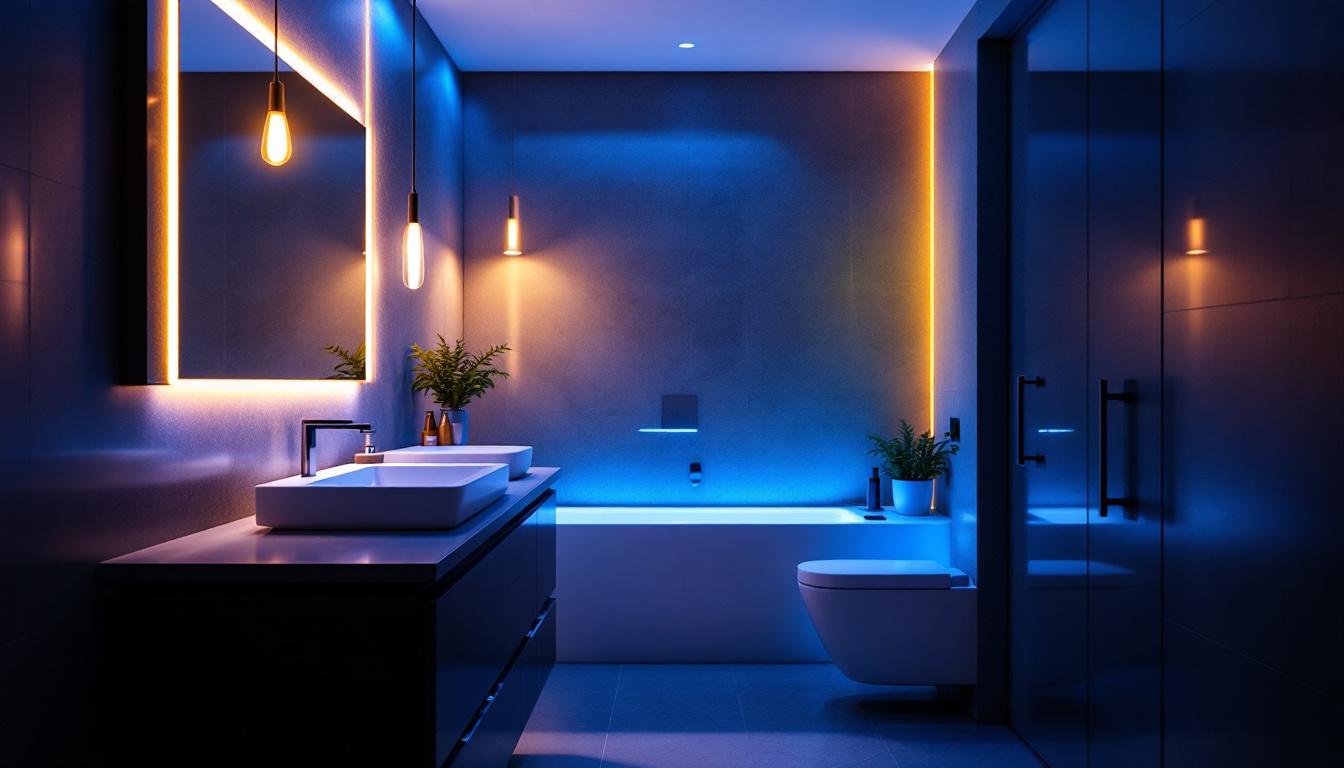
Lighting plays a crucial role in the design and functionality of any bathroom. With the rise of LED technology, lighting contractors are presented with new opportunities and challenges. Understanding the science behind bathroom LED lighting is essential for creating effective, energy-efficient solutions that meet the needs of clients. This article delves into the intricacies of LED lighting, its benefits, and considerations specific to bathroom environments.
Light Emitting Diodes (LEDs) are semiconductor devices that emit light when an electric current passes through them. Unlike traditional incandescent bulbs, which generate light by heating a filament, LEDs produce light through a process known as electroluminescence. This fundamental difference contributes to their efficiency and longevity. The lifespan of an LED can reach up to 50,000 hours, which means you can enjoy bright, reliable lighting for years without the hassle of frequent replacements.
LEDs are available in various colors and can be easily integrated into different lighting designs. Their compact size allows for greater versatility in placement, making them an ideal choice for bathrooms, where space can be limited. Beyond just aesthetic appeal, LEDs can also be used to create mood lighting, enhancing the overall ambiance of the space. With options ranging from soft, warm tones to bright, invigorating hues, homeowners can tailor their lighting to suit their personal style and needs.
The science behind LEDs involves the movement of electrons within a semiconductor material. When electricity flows through the diode, electrons recombine with holes (the absence of electrons) in the semiconductor, releasing energy in the form of photons. This process is highly efficient, resulting in less wasted energy compared to traditional lighting options. Notably, this efficiency translates not only into lower energy bills but also into a reduced carbon footprint, making LEDs a more environmentally friendly choice.
Moreover, the color of the light emitted by an LED is determined by the materials used in its construction. By adjusting the composition of the semiconductor, manufacturers can produce LEDs that emit a wide spectrum of colors, including warm whites, cool whites, and even vibrant colors. This versatility allows for creative lighting solutions in various settings, from residential homes to commercial spaces, where specific lighting effects can enhance the overall design and functionality.
One of the most significant advantages of LED lighting is its energy efficiency. LEDs consume significantly less power than incandescent or fluorescent bulbs, leading to lower electricity bills for homeowners. Additionally, they have a much longer lifespan, often lasting up to 25 times longer than traditional bulbs. This longevity reduces the frequency of replacements, which can be particularly beneficial in high-maintenance areas like bathrooms. Furthermore, the reduced need for replacements contributes to less waste, aligning with sustainable practices that are increasingly important in today’s world.
Another advantage is the reduced heat output of LEDs. Traditional bulbs can generate a significant amount of heat, which can be uncomfortable in small spaces and may even pose a fire hazard. LEDs, on the other hand, remain cool to the touch, making them a safer option for bathroom environments. This characteristic not only enhances safety but also allows for more flexible design choices, such as placing lights closer to mirrors or within enclosed spaces without the risk of overheating. As a result, homeowners can achieve both functionality and style in their lighting solutions, creating a space that is both inviting and practical.
While the benefits of LED lighting are clear, several factors must be considered when implementing these solutions in bathrooms. Lighting contractors must take into account the unique requirements of this space, including humidity levels, fixture placement, and the overall design aesthetic.
Bathrooms are inherently humid environments, which can pose challenges for lighting installations. It is crucial to select LED fixtures that are rated for damp or wet locations to ensure safety and longevity. These fixtures are designed to withstand moisture without compromising performance or safety.
Additionally, contractors should consider the placement of fixtures to minimize exposure to direct water. For example, recessed lighting can be an excellent option for providing ambient light while keeping fixtures protected from splashes. Wall sconces and vanity lights should also be installed at a safe distance from water sources, such as sinks and showers.
Effective bathroom lighting typically involves a layered approach, combining ambient, task, and accent lighting. Ambient lighting provides general illumination, while task lighting focuses on specific areas, such as mirrors and vanities. Accent lighting can highlight architectural features or decorative elements.
When planning the layout, contractors should consider the height and placement of fixtures. For example, vanity lights should be positioned at eye level to minimize shadows on the face, ensuring adequate illumination for grooming tasks. Recessed lighting can provide even ambient light, while dimmable options allow for flexibility in brightness, catering to different moods and activities.
The color temperature of LED lighting is another critical factor to consider. Measured in Kelvin (K), color temperature influences the ambiance and functionality of a bathroom. Warmer temperatures (2700K-3000K) create a cozy, inviting atmosphere, while cooler temperatures (4000K-5000K) offer a more clinical, energizing feel.
For bathrooms, a common recommendation is to use a color temperature between 3000K and 4000K. This range provides a balance of warmth and brightness, making it suitable for various activities, from relaxing baths to morning routines. However, personal preference and the overall design of the bathroom should also guide the selection process.
It is essential to consider the color rendering index (CRI) of the LEDs as well. A higher CRI (90 and above) ensures that colors appear true to life, which is particularly important in spaces where individuals apply makeup or select clothing based on color.
As energy efficiency becomes increasingly important, bathroom LED lighting presents an opportunity for contractors to promote sustainable practices. LEDs consume less energy, which translates to reduced carbon footprints for homeowners. Additionally, many LED products are now available with eco-friendly certifications, making them an attractive choice for environmentally conscious clients.
Contractors can also educate clients about the long-term cost savings associated with LED lighting. While the initial investment may be higher than traditional options, the reduced energy consumption and extended lifespan of LEDs lead to significant savings over time.
As technology continues to evolve, innovative applications of LED lighting are emerging in bathroom design. From smart lighting systems to integrated features, these advancements offer exciting possibilities for lighting contractors.
Smart lighting systems allow homeowners to control their bathroom lighting remotely through smartphones or voice-activated devices. This technology enables users to adjust brightness, color temperature, and even set schedules for lighting based on their routines.
Incorporating smart lighting into bathroom designs can enhance convenience and energy efficiency. For instance, motion sensors can automatically turn lights on and off, ensuring that energy is not wasted when the bathroom is unoccupied. Contractors should stay informed about the latest smart lighting products and trends to offer clients cutting-edge solutions.
Another innovative trend is the integration of LED lighting into bathroom fixtures themselves. For example, mirrors with built-in LED lighting provide both functional and aesthetic benefits. These mirrors often feature adjustable color temperatures and brightness levels, allowing users to customize their lighting experience.
Additionally, LED strip lighting can be used to create ambient effects around vanities, under cabinets, or along architectural features. This type of lighting adds depth and visual interest to the space while providing practical illumination.
For lighting contractors, understanding the best practices for installing LED lighting in bathrooms is essential for ensuring optimal performance and client satisfaction. Proper installation not only enhances the functionality of the lighting but also contributes to the overall aesthetic of the space.
When installing LED fixtures, it is crucial to follow electrical codes and guidelines to ensure safety and compliance. Since LEDs operate at lower voltages, contractors should ensure that the wiring is compatible with the fixtures being installed. Using appropriate transformers or drivers is essential for maintaining the longevity and performance of the LEDs.
Additionally, contractors should consider the use of dimmers with LED fixtures. Not all dimmers are compatible with LED technology, so it is vital to select dimmers specifically designed for use with LEDs to avoid flickering or reduced lifespan.
After installation, thorough testing of the lighting system is essential. Contractors should check for uniformity in brightness and color temperature across all fixtures. Any discrepancies should be addressed before completing the project to ensure that the client is satisfied with the final result.
Quality assurance also involves educating clients on the proper care and maintenance of their LED lighting systems. Providing guidance on cleaning and troubleshooting can help clients maximize the lifespan and performance of their lighting solutions.
Bathroom LED lighting offers a myriad of benefits for both homeowners and lighting contractors. Understanding the science behind LED technology, along with considerations specific to bathroom environments, enables contractors to create effective and aesthetically pleasing lighting solutions.
By staying informed about the latest trends and innovations in LED lighting, contractors can provide clients with energy-efficient, sustainable options that enhance the functionality and beauty of their bathrooms. As the demand for modern, efficient lighting solutions continues to grow, embracing the science of LED lighting will position contractors for success in this evolving industry.
Ready to elevate your bathroom lighting projects with the efficiency and elegance of LED technology? At LumenWholesale, we provide lighting contractors with an exceptional range of high-quality, spec-grade LED lighting products at unbeatable wholesale prices. Say goodbye to local distributor markups and hello to superior lighting solutions that meet the highest industry standards. With our commitment to reliability and performance, plus the convenience of free shipping on bulk orders, you can trust LumenWholesale to light up your projects with value and convenience. Don’t compromise on quality or cost—choose Wholesale Lighting at the Best Value and make your next bathroom LED lighting installation a shining success.

Discover effective strategies for lighting contractors to tackle common challenges with outdoor wire connectors.

Discover why 40 Watts Type G outdoor bulbs are essential for lighting contractors.

Discover essential strategies and tips for lighting contractors on transforming basements with string lights.

Discover the transformative impact of online LED light stores through real-world success stories from lighting contractors.